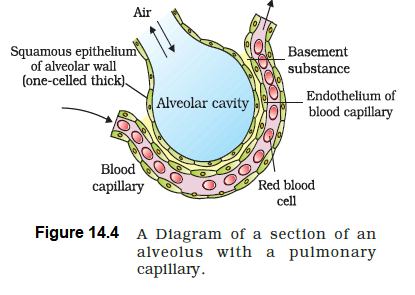14.3 Exchange of Gases
Alveoli are the primary sites of exchange of gases. Exchange of gases also occur between blood and tissues. \(\mathrm{O}_2\) and \(\mathrm{CO}_2\) are exchanged in these sites by simple diffusion mainly based on pressure/concentration gradient. Solubility of the gases as well as the thickness of the membranes involved in diffusion are also some important factors that can affect the rate of diffusion.
Pressure contributed by an individual gas in a mixture of gases is called partial pressure and is represented as \(\mathrm{pO}_2\) for oxygen and \(\mathrm{pCO}_2\) for carbon dioxide. Partial pressures of these two gases in the atmospheric air and the two sites of diffusion are given in Table 14.1 and in Figure 14.3. The data given in the table clearly indicates a concentration gradient for oxygen from alveoli to blood and blood to tissues. Similarly,a gradient is present for \(\mathrm{CO}_2\) in the opposite direction, i.e., from tissues to blood and blood to alveoli. As the solubility of \(\mathrm{CO}_2\) is 20-25 times higher than that of \(\mathrm{O}_2\), the amount of \(\mathrm{CO}_2\) that can diffuse through the diffusion membrane per unit difference in partial pressure is much higher compared to that of \(\mathrm{O}_2\). The diffusion membrane is made up of three major layers (Figure 14.4) namely, the thin squamous epithelium of alveoli, the endothelium of alveolar capillaries and the basement substance (composed of a thin basement membrane supporting the squamous epithelium and the basement membrane surrounding the single layer endothelial cells of capillaries) in between them. However, its total thickness is much less than a millimetre. Therefore, all the factors in our body are favourable for diffusion of \(\mathrm{O}_2\) from alveoli to tissues and that of \(\mathrm{CO}_2\) from tissues to alveoli.
Table 14.1 Partial Pressures (in mm Hg) of Oxygen and Carbon dioxide at Different Parts Involved in Diffusion in Comparison to those in Atmosphere
\(\begin{array}{|c|c|c|c|c|c|}
\hline \begin{array}{c}
\text { Respiratory } \\
\text { Gas }
\end{array} & \begin{array}{c}
\text { Atmospheric } \\
\text { Air }
\end{array} & \text { Alveoli } & \begin{array}{c}
\text { Blood } \\
\text { (Deoxygenated) }
\end{array} & \begin{array}{c}
\text { Blood } \\
\text { (Oxygenated) }
\end{array} & \text { Tissues } \\
\hline \mathrm{O}_2 & 159 & 104 & 40 & 95 & 40 \\
\hline \mathrm{CO}_2 & 0.3 & 40 & 45 & 40 & 45 \\
\hline
\end{array}
\)

